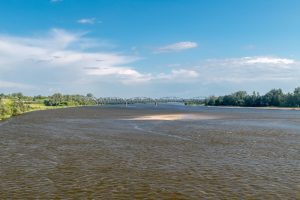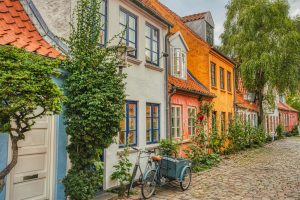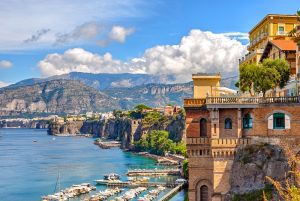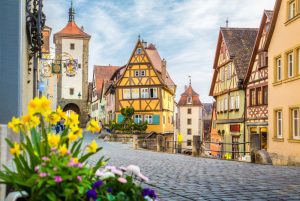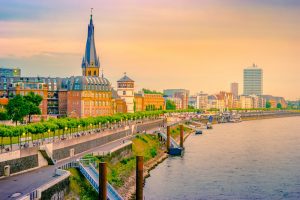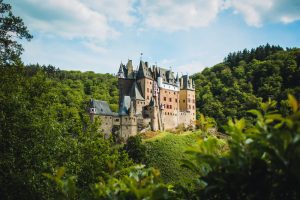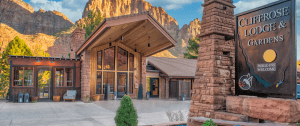Germany is a country full of beautiful and diverse landscapes. You’ll find everything from sleepy seaside resorts and booming metropolises to quaint medieval villages and river cities steepled in vineyards.
Some of Germany’s best and most stunning terrain can be found in the alluring and mysterious mountainsides. Some of the most mountainous regions in the country include Bavaria to the southeast, North Rhine-Westphalia to the west, and Baden-Württemberg to the southwest.
Whether you’re searching for a dazzling ski destination or a charming town off the beaten path, check out our list of the 18 best mountainous towns and cities to visit in Germany.
Table of Contents
1. Garmisch-Partenkirchen
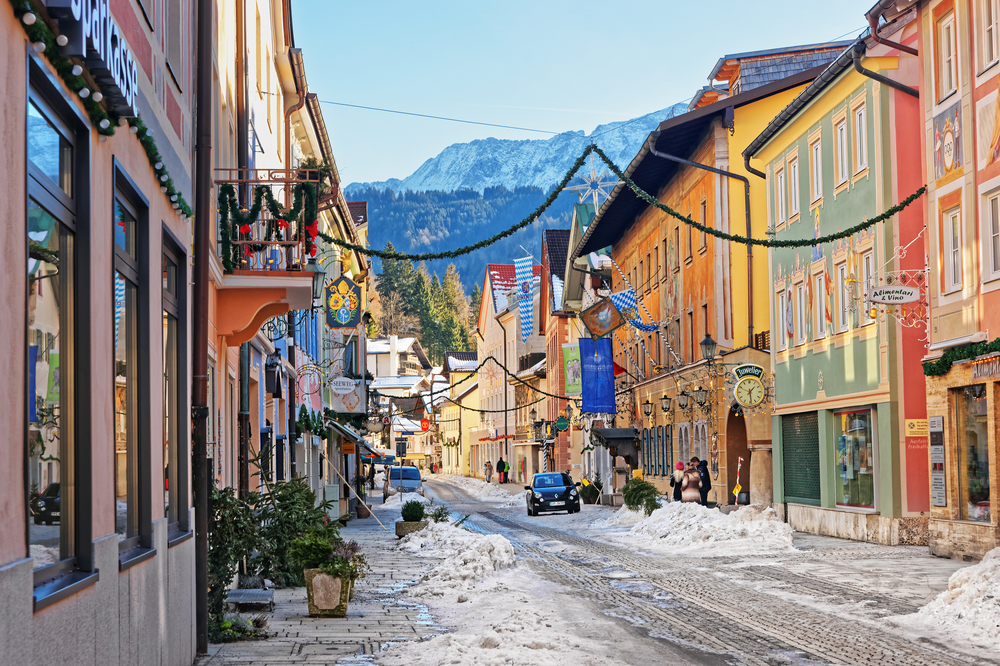
One of the most famous mountain towns in Germany is Garmisch-Partenkirchen, located in southern Bavaria. This iconic mountain village is extremely popular with winter sports enthusiasts, thanks to its convenient location in the Bavarian Alps.
The towns of Garmisch and Parenkirchen joined together for the 1936 Winter Olympics, and have been in a happy partnership ever since. The Garmisch side of town is a bit more modern, while the Partenkirchen area has retained its old-school Bavarian charm with cobblestone streets and half-timbered houses.
No matter where you are in town, you’ll be surrounded by stunning views of the alps and the crisp, clean air that can only be found in the mountains.
If you’re visiting in the winter, don’t hesitate to hit the slopes, spend some time skating in the Olympic ice-skating stadium, or take a romantic sleigh ride around town.
The summer is a great time to visit for those who want to avoid the crowds, and you’ll find plenty of hiking trails in and around the city.
Garmisch-Partenkirchen is also close to Germany’s highest peak, the Zugspitze, and a ride to the top via the cogwheel train and cable car is basically a rite of passage for anyone visiting this cozy mountain village.
Once you get hungry, stop by one of the steamy cafés for a homemade pastry and cup of hot coffee, or sit down for a meal at one of the many restaurants that offer classic German fare and beer.
2. Schönau am Königssee
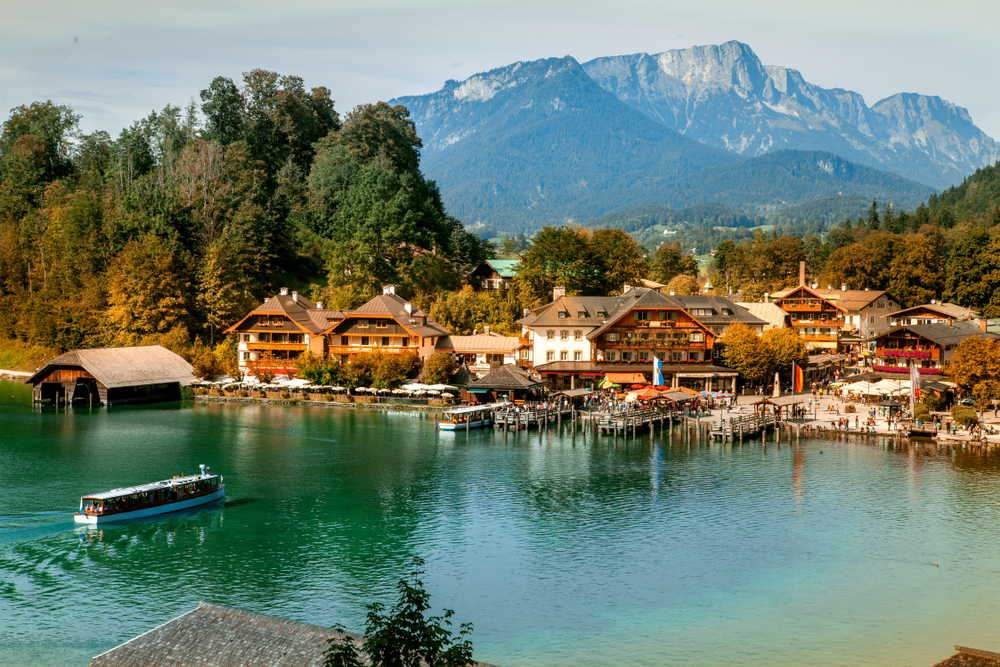
One of the best mountainous towns to visit in Germany is tucked away in the southeast corner of Bavaria. Schönau am Königssee is situated on the northern end of the breathtaking Königssee Lake, and the mountainous backdrop of this idyllic town will make you feel like you’ve stepped straight into a fairy tale.
Schönau am Königssee is especially popular in the winter, as once the lake freezes over it becomes a stunning mirror for the surrounding Berchtesgaden Alps.
You’ll also find over a dozen miles of tracks for skating. The city is also home to a luge, bobsled, and skeleton track (the oldest one in the world!).
Schönau am Königssee is extremely beautiful in the summertime, too, and a boat tour around the lake is one of the best ways to take in the verdant mountain views. Of course, you could always opt to take in views of this beautiful lake with a beer in hand from one of the restaurant patios overlooking the water.
Those looking for a more active experience in Schönau am Königssee should go for a hike on one of the many scenic trails in the area. The Malerwinkweg is a fairly easy trail that’ll take you through its namesake’s national forest along the edge of the lake, and the slightly more intense Rabenwand Trail will give you views from higher up as it leads you to the Königsbachwasserfall.
3. Monschau
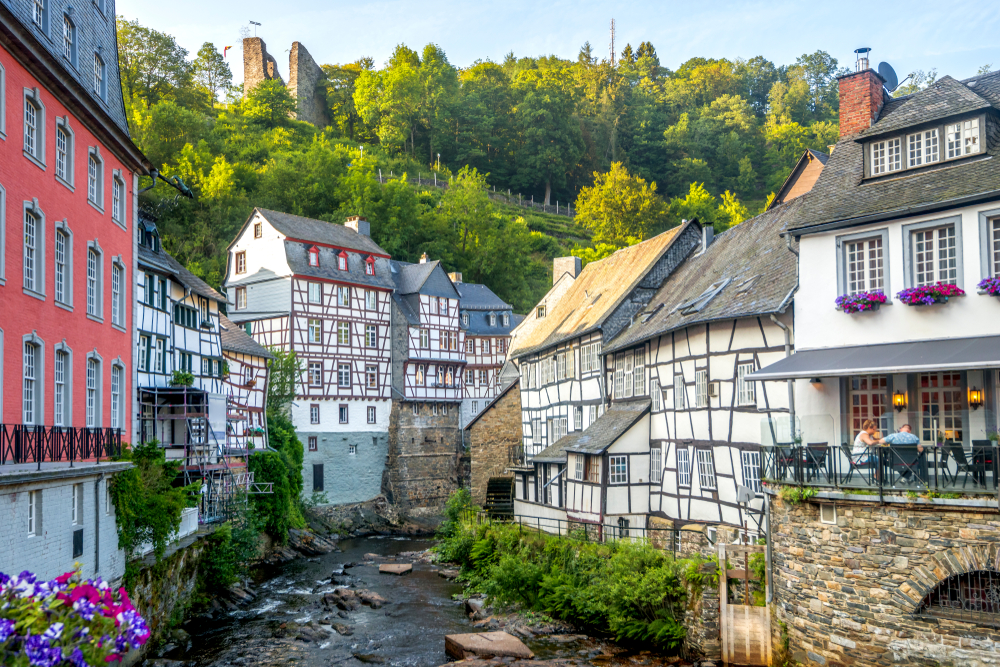
Located on the Belgian border in the southwestern corner of North Rhine-Westphalia, Monschau is one of the best mountain towns to visit in Germany and also one of the Top 20 Best Day Trips from Cologne, Germany.
Not only is it extremely picturesque, but it’s rich history dates back to the beginning of the 12th century. You can see the city’s age in its leaning half-timbered houses and narrow cobblestone streets, and there are numerous museums tucked into ancient buildings around town.
One of the best ways to learn about the town’s history is by tasting it. Monschau is famous for its mustard, so don’t hesitate to indulge a bit while you’re in town.
As you wander around the charming streets, you’ll find lots of cozy cafes and restaurants – and the best ones will have outdoor seating overlooking the scenic Ruhr River.
You could also admire the river from a different angle by booking a whitewater rafting excursion, or head into the nearby Eifel National Park and hike along its shores.
While in Monschau, you shouldn’t miss the lovely Monschau Castle. This ancient edifice looms above the city and is now used as a youth hostel and open-air music venue.
If you’d like to stay a night or two and explore this verdant area but don’t fancy the idea of a youth hostel, you’ll find plenty of charming hotels in the town center.
4. Schiltach

For another one of Germany’s best mountain towns, head to the Upper Kinzig Valley in the Black Forest. Here, you’ll find the charming town of Schiltach, a village whose history dates back to the 11th century.
This idyllic river town brags beautiful alpine views, classic medieval architecture, and a host of intriguing museums. One of the best things about visiting Schiltach is that it’s a very well-kept secret, so there’s no need to worry about flocks of tourists crowding the streets. What’s not to love?
The most notable of the 4 museums in town is the Schüttesäge Museum, where you can learn all about the town’s timber rafting industry and other ways the raftsmen utilized the timber.
Another big part of Schiltach’s culture is tanning, and the Black Forest’s oldest tannery is located in this tiny town. You’ll find few other craft tanneries around the country that produce as high quality of leather as the Trautwein Company, and you can even make an appointment to view the tanner’s handiwork while you’re in town.
A walking tour through this ancient village will also give you a sense of its history, and the river promenade is a great way to take in the stunning mountain views.
5. Füssen
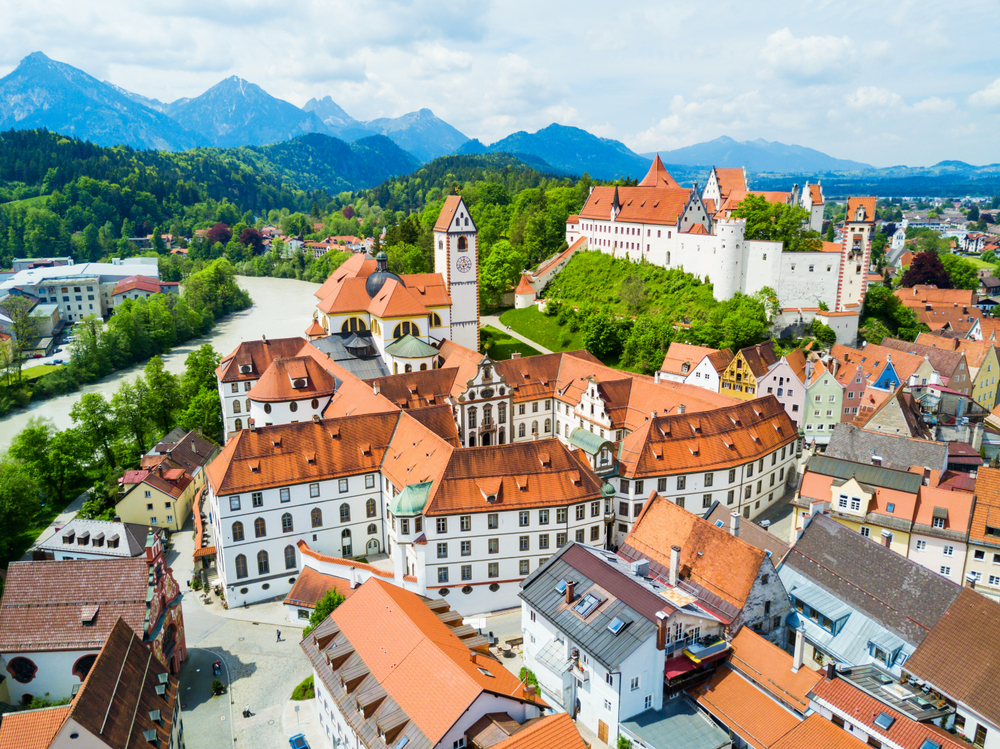
Those in search of the best mountain cities to visit in Germany shouldn’t miss the Bavarian town of Füssen. Located just north of the Austrian border, Füssen is the perfect home base for exploring the nearby mountainsides and waterways.
The town is perched on the scenic shores of the Lech River and Forggensee Lake, and boasts stunning views of the nearby mountains.
The Tegelberg Mountain is home to a ski resort and alpine slide, and those in search of a more tranquil experience can spend the day exploring the famous Neuschwanstein Castle located just a few minutes to the southeast.
Of course, you could always stay within city limits and admire the ancient architecture and beautiful river views while wandering the streets. You could also visit Hohes Schloss, the town’s castle, check out the Benedictine Monastery of St. Mang (which houses the violin and lute museum), or head down to the lake for some hiking and swimming.
Once you’re ready for a break, make a beeline for the Bierstubbe at Hotel Hirsch. This traditional Bavarian pub serves up tantalizing local dishes and delicious brews straight from Munich.
6. Baden-Baden
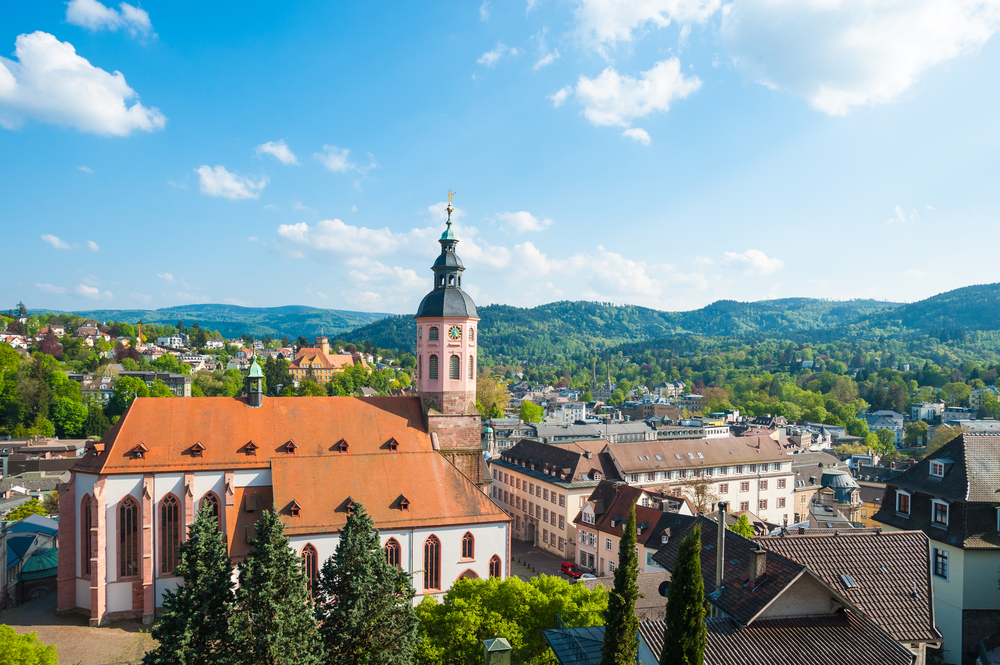
Situated in the southwestern Black Forest region, the city of Baden-Baden is one of the best mountainous towns to visit in Germany. This ancient spa town has been drawing people to the area for thousands of years, and you can still frequent the same bubbling thermal baths, or soak in a sea salt grotto as you stare up at stalactites.
Baden-Baden is also home to Europe’s steepest funicular railway, and a ride up the forested Merkur Mountain is the best way to get panoramic views of the lovely city and surrounding area.
You could also take a hike up to the ruins of the Schloss Hohenbaden, take a promenade through the old parts of town, or indulge in some locally made truffles washed down with a warm cup of coffee.
Perhaps the most iconic part of Baden-Baden, however, is the luxurious Kurhaus Complex. This lavish building is home to a spa resort and ritzy casino, and those looking for a glamorous mountain getaway while in Germany would be hard-pressed to find a better spot.
Of course, if you’re not looking to empty out your pockets, you could always opt to explore these lovely grounds for the day.
7. Bremm
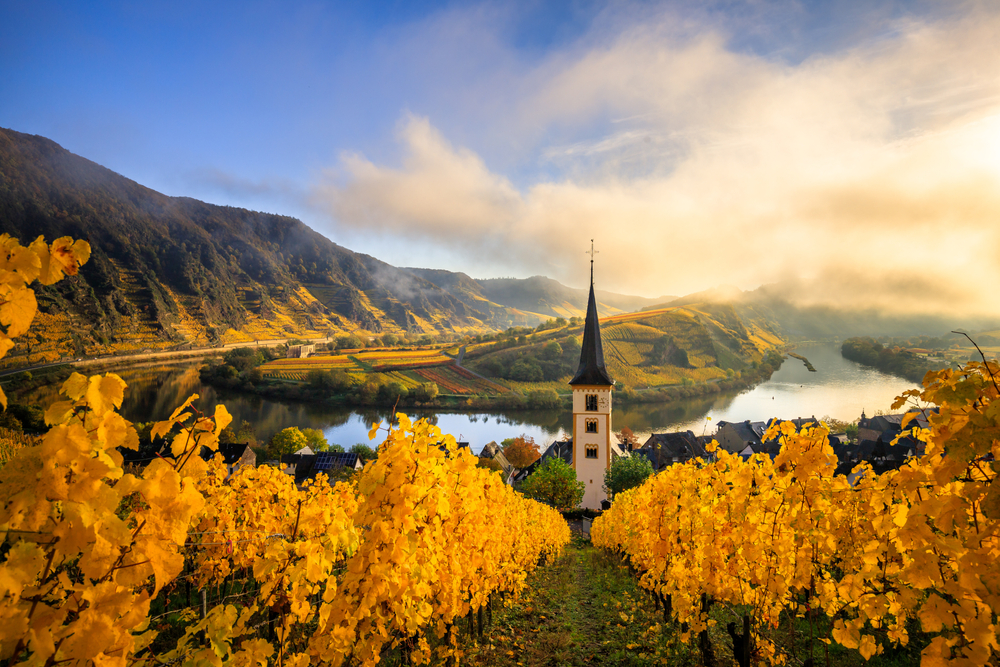
Quaint towns and picturesque cities are abundant in the Rhineland-Palatinate region, and the charming village of Bremm is no exception. The best thing to do in this sparsely populated area is to take in the stunning views, and you’ll find them around every turn.
Bremm is situated on the scenic Moselle River and surrounded by lush mountainsides. There are plenty of hiking trails that’ll reward you with incredible views of the surrounding areas.
For one of the best vistas, hike up to the Moselschleife Bremm Aussichtspunkt for a view of the famous Moselle Loop, where the river bends in a horseshoe-like shape. For the best cityscapes, walk up past the church into the surrounding vineyards – but just be sure to stick to the paths.
Once you’ve worked up a thirst from all the hiking, make a beeline back into town and enjoy a refreshing glass of crisp Riesling, the sweet white wine that this region is famous for. You’ll also find a few restaurants around town, though there are admittedly more options for wine than there are for food.
You likely won’t get to visit all the wineries in just one day, so if you’d like to stick around for a day or two there are plenty of guest houses and hotels in Bremm.
8. Oberammergau
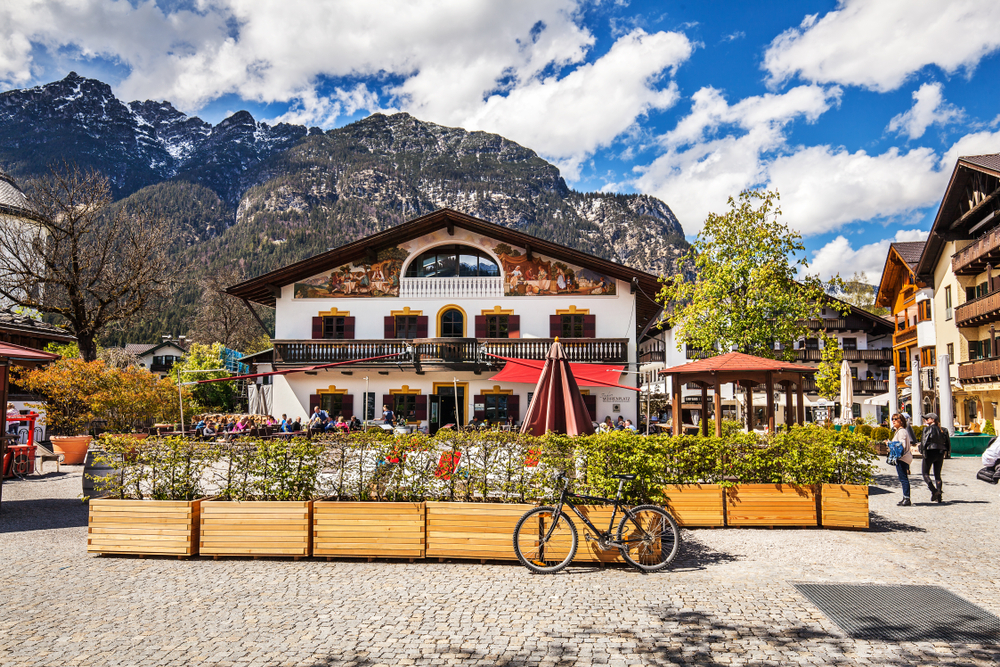
The village of Oberammergau is easily one of the most charming in the country, making it an easy choice for one of the best mountainous towns in Germany. Nestled in the verdant meadows of the Bavarian Alps, Oberammergau is a great alternative for those looking to avoid the crowds of the ever-popular Garmisch-Partenkirchen, located to the south.
This little mountain village is incredibly picturesque, and is known for its beautifully painted houses, cobblestone streets, and artisan craft shops.
The town is also home to some stunning frescoes painted by Franz Seraph Zwinck back in the 1700s, and some interesting architecture like the onion-shaped dome of the Church of Saint Peter and Paul.
If you’re interested in architecture, take a trip south into the nearby town of Ettal and spend the day wandering through the Ettal Abbey. Those more interested in German beers can take a tour of the brewery located across the way.
Another of Oberammergau’s claims to fame is the Passion Play performance, performed only once a decade since the 17th century. The play was canceled in 2020 due to COVID-19 concerns, so if you’re lucky, you may be able to catch the performance in the next few years.
9. Freiburg im Breisgau
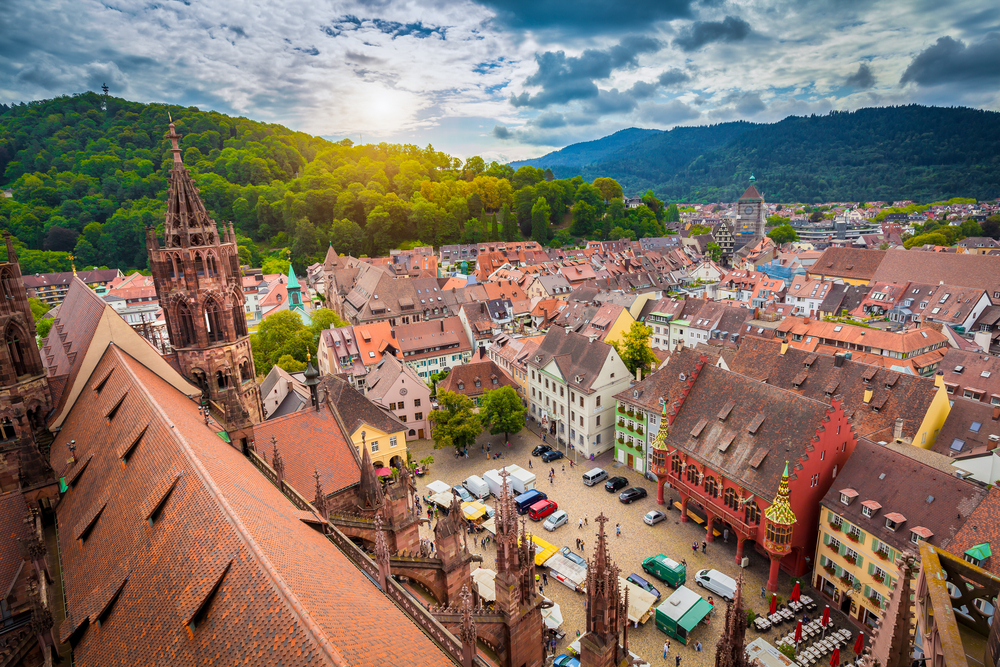
Sitting at the base of various mountain peaks in the Black Hills region of southwest Germany is Freiburg im Breisgau. This vibrant university town is one of the best mountainous cities in the country, and offers an abundance of outdoor recreation and beautiful brooks that cross through the city center.
Schlossberg, also known as “Castle Hill”, is a forested hiking area that can be easily accessed from city center. Unfortunately, there are no castles on the hill today – but the views across the town certainly are fit for royalty. If you’re not keen on hiking all the way to the top, you can always hitch a ride on the funicular railway.
Those looking for even more incredible views can head up to Feldberg, Baden-Württemberg’s tallest mountain. The peak is located about an hour south of Freiburg im Breisgau, and those who aren’t looking for a strenuous hike can take the cable car to the top. Once there, you’ll have access to hiking trails, a skiing area, and a viewing tower.
If you want to stick closer to town, you’ll have plenty to keep you busy right in the city. One of the most picturesque places is in the reconstructed Old Town, or Altstadt, in local speak, where you’ll find a magnificent Gothic cathedral, some original city gates from the middle ages, and plenty of little shops and cafes.
10. Schwäbisch Hall
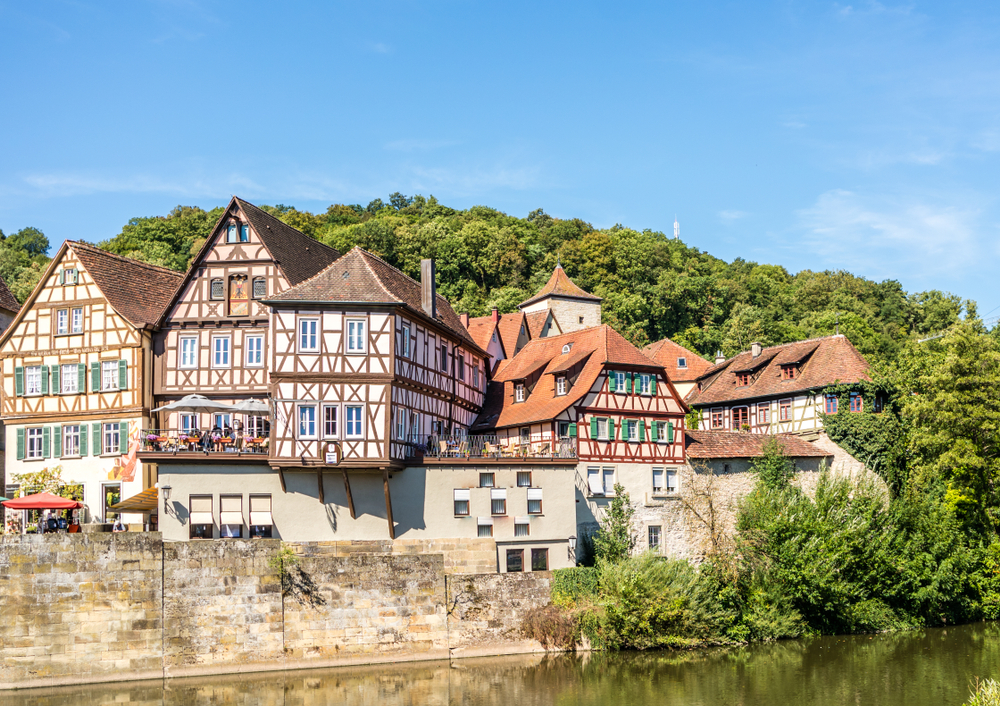
Schwäbisch Hall (often referred to simply as “Hall”) is one of the best mountainous towns to visit in Germany. Located in the northeastern part of Baden-Württemberg near the Bavarian border, this rural river city flies under the radar all too often – which can be a bonus for those looking to escape some of the more touristy mountain towns
This unsung gem is bursting with historic and picturesque features. The higgledy-piggledy lanes are lined with medieval half-timbered houses, and the backdrop of the Kocher River and surrounding mountains make this town one that truly belongs in the storybooks.
The town built its riches from harvesting “white gold” (better known today as salt), and the city has retained much of its original buildings and monuments. All around town, you’ll find beautiful stone bridges crisscrossing the river, cafes buzzing with locals, and some top-rated museums that’ll give you a little more insight into Schwäbisch Hall’s history.
Check out the Hohenloher Freilandmuseum – an open-air farming museum that showcases some of the area’s most famous residents, the rare black-spotted pig.
You’ll have a large variety of restaurants to choose from when you get hungry, and you’ll find everything from German and Austrian fare to international delights. There are also plenty of pubs and wine bars to choose from if you feel the need to wash your dinner down with some local drink.
11. Blaubeuren
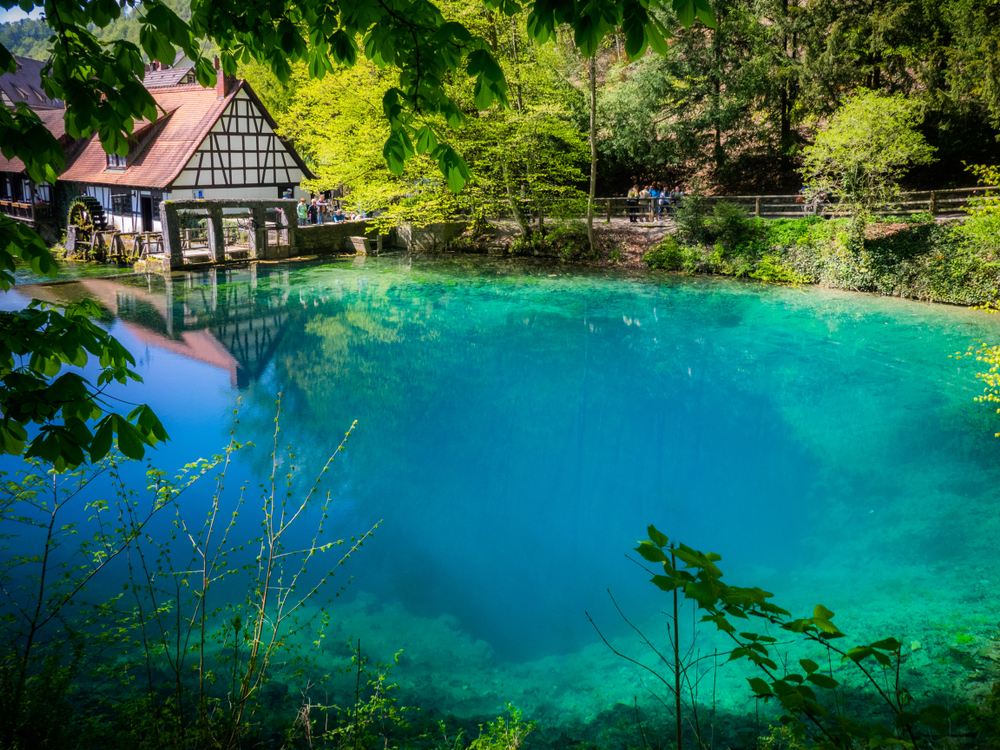
Located in the hills of the Baden-Württemberg, the city of Blaubeuren is as picturesque as they come and offers visitors an endless amount of photo-ops. Blaubeuren is also steeped in history and fairy-tale-like myths, much of which is inspired by the ultra-blue waters of the Blautopf.
This surreal spring has attracted visitors to Blaubeuren for centuries, and the remarkable coloring is actually due to its vast depth. Folklore has it that it was deep enough for mermaids, but the real explanation is that it’s the endpoint for a vast cave system.
The Hohle Fels is another nearby cave system that has seen many important archaeological digs, with most finds dating back to the Upper Paleolithic period. For more information about this ancient cave, you can head back into town and visit the Museum of Prehistory.
The town itself is also rich in history, and you’ll be able to see it in the half-timbered houses and medieval-era monastery.
You could also munch down on some traditional Swabian cuisine if you prefer to taste your way through history, and the best place to do so is at the lovely and tasty Hotel Löwen.
12. Goslar
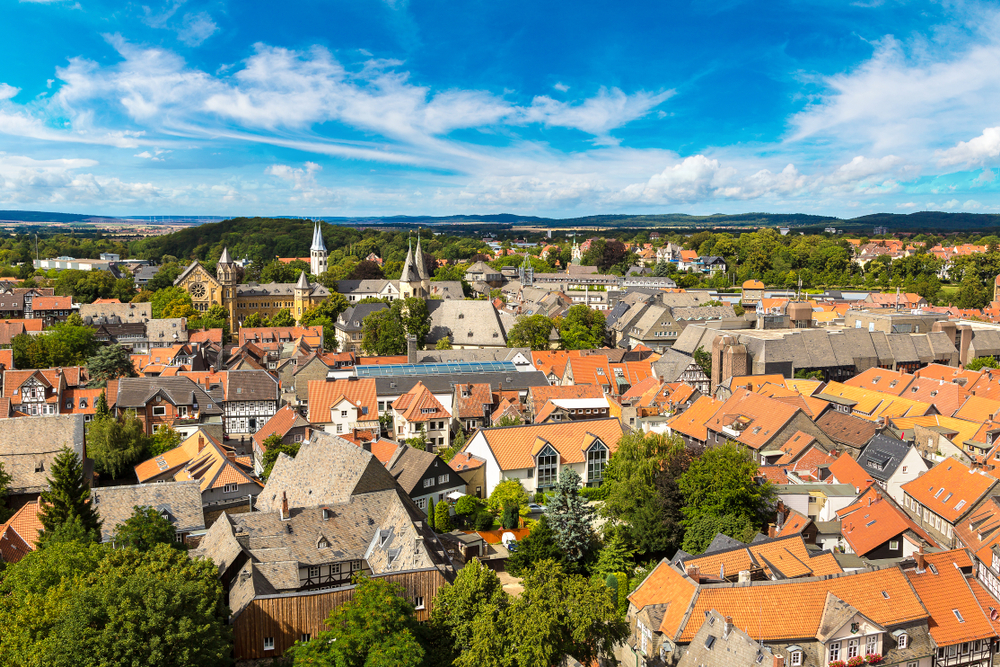
Another medieval treasure can be found in the Harz Mountains. The mountain town of Goslar has a long history, and is home to 3 UNESCO World Heritage Sites.
Goslar dates back to 922 AD when silver and copper ore were discovered in the nearby mountainsides. The town was founded by Heinrich I after this discovery.
Learn all about its fascinating history at the Rammelsberg Mine and Museum (one of the town’s World Heritage Sites). You can even enter into Europe’s oldest mining chamber where you’ll have numerous guided tour options to choose from.
The Imperial Palace of Goslar is another historical monument that has been impeccably preserved, and this 11th-century palace definitely deserves a visit. It’s part of the greater Imperial Old Town of Goslar, which is the second UNESCO World Heritage Site.
After you tour the castle, be sure to walk down the enchanting cobblestone streets of the Altstadt and inhale the medieval atmosphere.
Unfortunately, the incredible history and beautiful architecture of Goslar hasn’t gone unnoticed, and the city plays host to busloads of tourists during summer months.
You could always book a hotel and head into the wilderness during the day to escape the crowds, but be sure you do so well ahead of time as accommodations in Goslar fills up fast.
13. Heidelberg
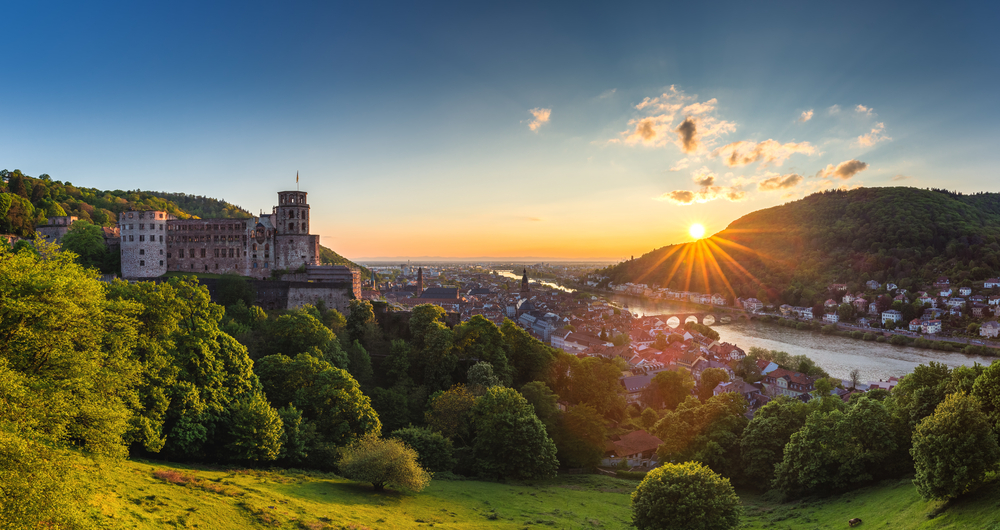
Germany’s oldest university city is also one of its most scenic mountain towns, and Heidelberg is a favorite with Germans and tourists alike. It’s also one of the Top 16 Best Cities to Visit in Germany, According to Lonely Planet
Located on the banks of the Neckar River in the Baden-Württemberg region, Heidelberg is renowned for its unified red-roofed houses, its rich literary history, and (like so many other German towns) a half-ruined hilltop castle.
Heidelberg is unlike many other German towns in the fact that it emerged virtually unscathed after World War II. That being said, it was basically destroyed in the 17th century by French troops – but there are still tons of beautiful buildings to see around town, including the aforementioned castle.
You’ll definitely want to pencil in some time to see the historic university grounds and the old student dungeons that have since been turned into a museum.
Heidelberg is also home to one of Germany’s best Christmas markets, so you may want to consider visiting in the winter.
14. Marburg

Just an hour north of Frankfurt, you’ll find the university town of Marburg. The city is tucked into the hillsides of Hesse, and has everything you could hope for in a medieval German town.
Complete with a castle on a hill, half-timbered houses, and the oldest pure Gothic cathedral in the country, there’s much to love in Marburg.
The Landgrafenschloss is a 13th-century castle perched on the city’s highest point, and aside from providing you with astounding views, it’ll also give you a look into Marburg’s past.
The well preserved half-timbered houses along the Lahn River will allow you to pretend you’ve gone back in time, and if you’d like to learn more about the history of Marburg, you’ll find plenty of museums sprinkled around town.
Those looking to bask in the great outdoors should hike up to the Kaiser Wilhelm Tower, also known as the Spiegelslustturm, or take a more leisurely approach to outdoor recreation and enjoy a pedal boat ride along the scenic river.
Once you’re ready for some sustenance, head to Marktplatz, where you’ll find endless bars, restaurants, and cafes lining the old square. If you find this area to be too crowded, head up to one of the quieter side streets for more options.
15. Wernigerode
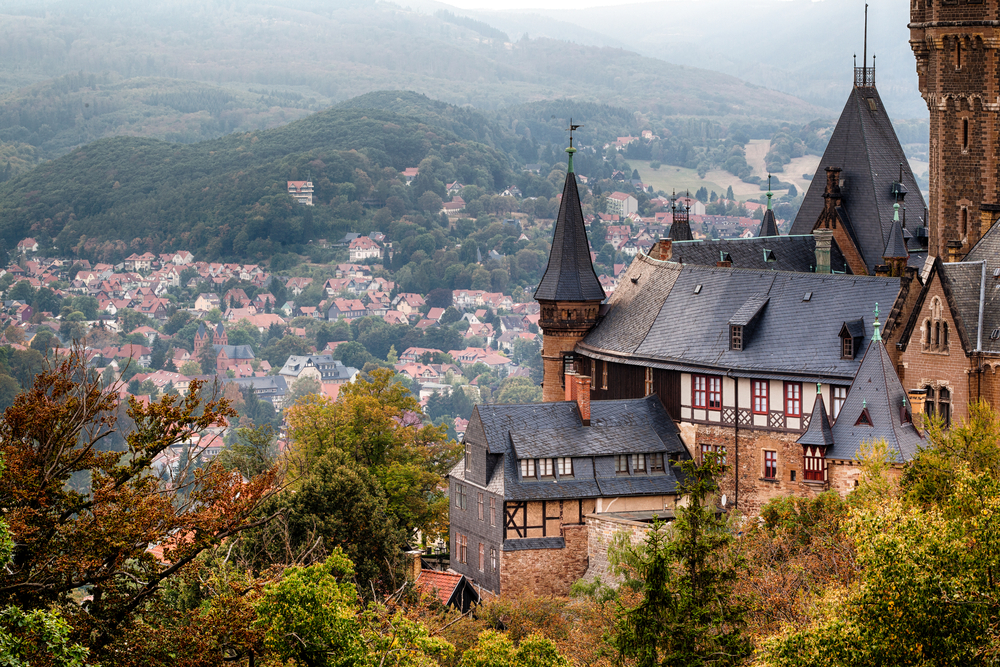
Situated on the northern fringe of the Harz Mountains, Wernigerode is one of Germany’s best mountain towns. It’s a classic medieval town with narrow cobblestone streets and iconic half-timbered houses, but there are a few things that make Wernigerode one of a kind.
One of the most noteworthy buildings in town is the Gothic town hall, with its ancient twin spires and its rust-colored façade. The square surrounding it is incredibly picturesque as well.
The 12th-century castle should also be sought out, as the picture-perfect edifice sits high above the city and offers sweeping views of the surrounding mountains and town.
One of the coolest things about Wernigerode is its location on the Harz Narrow Gauge Railway (HSB). The HSB is no ordinary railway. It utilizes vintage steam-powered locomotives and travels through the scenic Harz mountains from Wernigerode to Brocken, the highest peak in northern Germany.
This route will provide you with stunning views of the mountains, and the charming train ride is one you won’t soon forget.
16. Meersburg

Located on the lovely shores of Lake Constance in the Baden-Württemberg region, Meersburg is one of the best mountainous towns to visit in Germany. We admit that “mountain” might be a generous term here, but the little village of Meersburg is so stunning that it’s earned a spot on our list.
This tiny town is teeming with vineyards and orchards, and the beautiful blue lake adds to the breathtaking scenery. The best vista in town can be found at the medieval Meersburg Castle, with views of the lake, the distant Swiss Alps, and the city below.
The castle is surrounded by the historic Oberstadt, or Upper Town. After you’ve taken in all the views from above, you can wander down the charming cobblestone streets that are lined with half-timbered houses.
You’ll eventually make your way down to the Unterstadt, or Lower Town, and a walk along the seafront promenade is simply compulsory.
17. Altena
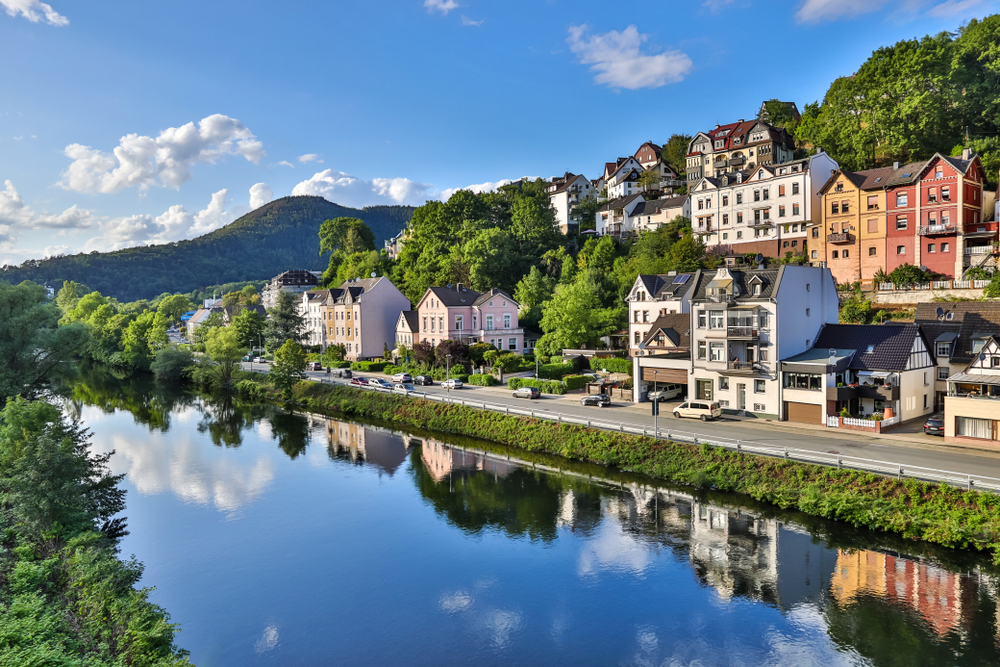
The small town of Altena is one of Germany’s most quintessential mountain towns, and of course, that includes a majestic hillside castle. Though these are somewhat of a common sight in the Rhine-Westphalia area, the Burg Altena is not any less breathtaking.
Altena was booming during the middle ages, and many of the townsfolk earned a living by making the wire that is used in chainmail shirts. Today, you can learn about that part of the city’s past and more history in the hilltop castle, and while you’re up there, you’ll be treated to dazzling views.
A hike up to the Aussichtspunkt am Brandweg will afford you some great views of the castle, city, and surrounding mountains. You could always walk around the town itself to get a sense of the place as well, and the verdant river promenade is one of the best places to do so.
18. St. Goarshausen
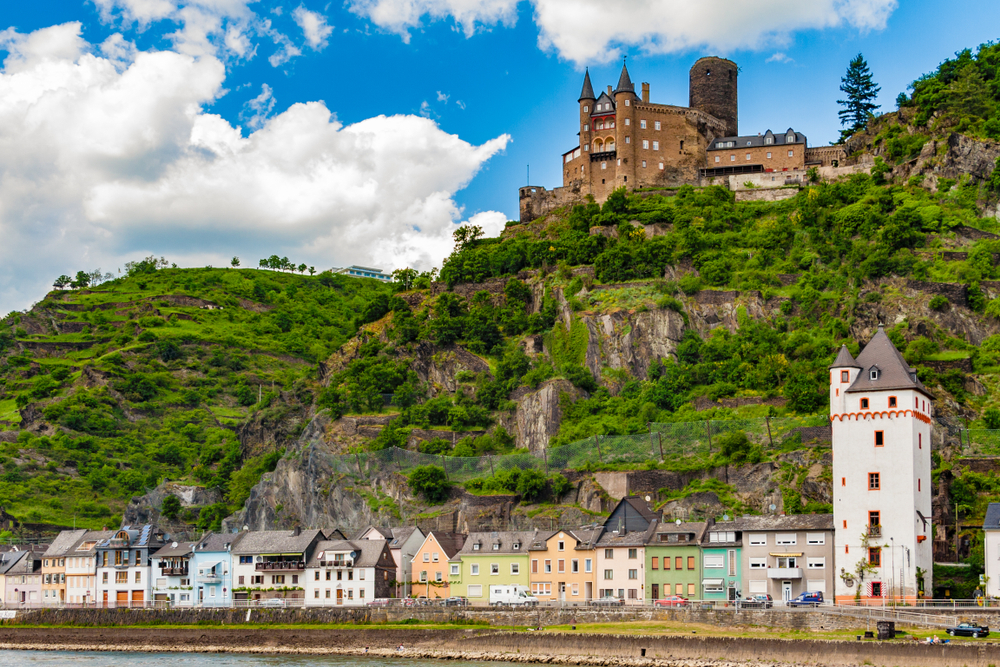
What’s better than a medieval castle perched high on a hill? Two of them! The historic city of St. Goarshausen does in fact brag 2 such fortresses, and you’ll even find the ruins of two more in the neighboring St. Goar.
Situated on the shores of the scenic Rhine River surrounded by gentle mountains, St. Goarshausen is a lovely place to spend some time while in Germany.
Burg Katz is the castle closest to town, and this 14th-century stronghold is now a private hotel. For enough money, anyone can live like royalty in St. Goarshausen, even if it’s just for a night. Hike up to the observation area for some incredible views of the surrounding mountains and towns below.
Burg Maus is just a few miles to the north. Though you won’t be able to stay overnight, you’ll be able to climb to the top of the main tower for some seriously spectacular views.
You’ll be able to hike up to both castles, and if you don’t feel like breaking a sweat to get to them, some of the nearby roads will get you pretty close.
One of the best things about this little river town is that it’s virtually unknown and criminally underrated, so there’s no need to worry about large crowds of tourists clogging these scenic streets.







